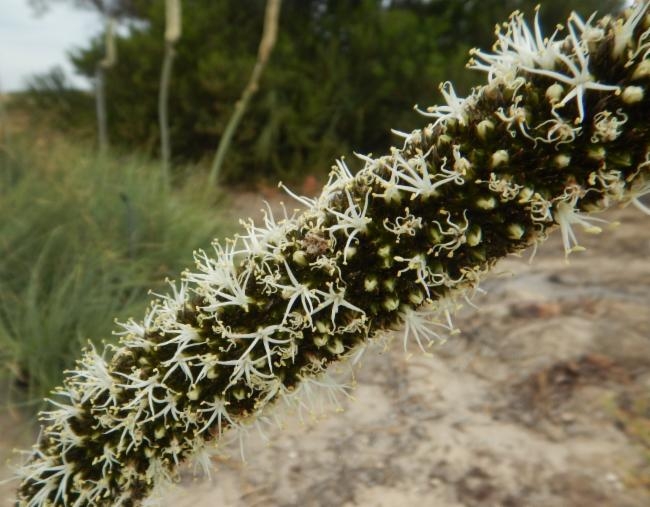Sand-Heath Grasstree
(Xanthorrhoea caespitosa)
Sand-Heath Grasstree (Xanthorrhoea caespitosa)
/
/

David Sando
CC BY 4.0
Image By:
David Sando
Recorded By:
Copyright:
CC BY 4.0
Copyright Notice:
Photo by: David Sando | License Type: CC BY 4.0 | License URL: http://creativecommons.org/licenses/by/4.0/ | Occurence ID: https://www.gbif.org/occurrence/2423546755 | Publisher: Atlas of Living Australia |








































































Estimated Native Range
Summary
Xanthorrhoea caespitosa, commonly known as Sand-Heath Grasstree, is an evergreen perennial native to the sandy heathlands and open woodlands of South Australia, where it thrives in nutrient-poor soils. This species typically grows to a height of 2-3 feet (0.6-0.9 meters) and a width of 1-2 feet (0.3-0.6 meters), featuring a grass-like clump of narrow, linear leaves and a central flowering spike. The flowers are white and densely packed on a tall stalk that rises above the foliage in the spring and summer, attracting pollinators such as bees and birds.
The Sand-Heath Grasstree is valued for its drought tolerance and unique architectural form, making it a striking addition to rockeries, native gardens, and as a specimen plant in xeriscapes. It is also fire-resistant, an adaptation to its fire-prone native habitat, and can resprout after bushfires. In cultivation, it requires minimal maintenance, preferring full sun to part shade and well-drained soils. Overwatering or poor drainage can lead to root rot, so it is important to mimic its natural dry conditions. While slow-growing, this plant can live for many years and is relatively free of pests and diseases.CC BY-SA 4.0
The Sand-Heath Grasstree is valued for its drought tolerance and unique architectural form, making it a striking addition to rockeries, native gardens, and as a specimen plant in xeriscapes. It is also fire-resistant, an adaptation to its fire-prone native habitat, and can resprout after bushfires. In cultivation, it requires minimal maintenance, preferring full sun to part shade and well-drained soils. Overwatering or poor drainage can lead to root rot, so it is important to mimic its natural dry conditions. While slow-growing, this plant can live for many years and is relatively free of pests and diseases.CC BY-SA 4.0
Plant Description
- Plant Type: Grass
- Height: 2-3 feet
- Width: 1-2 feet
- Growth Rate: Slow
- Flower Color: White
- Flowering Season: Spring, Summer
- Leaf Retention: Evergreen
Growth Requirements
- Sun: Full Sun, Part Shade
- Water: Low
- Drainage: Fast
Common Uses
Bee Garden, Bird Garden, Butterfly Garden, Fire Resistant, Low Maintenance, Showy Flowers
Natural Habitat
Native to sandy heathlands and open woodlands of South Australia
Other Names
Common Names: Tufted Grass-Tree, Grass Tree, Grass Gum-Tree, Kangaroo Tail
Scientific Names: , Xanthorrhoea caespitosa,
GBIF Accepted Name: Xanthorrhoea caespitosa D.J.Bedford